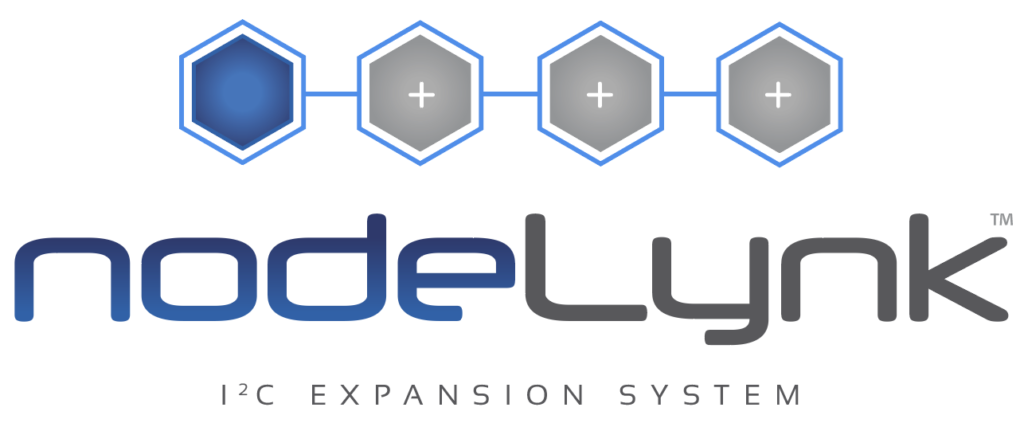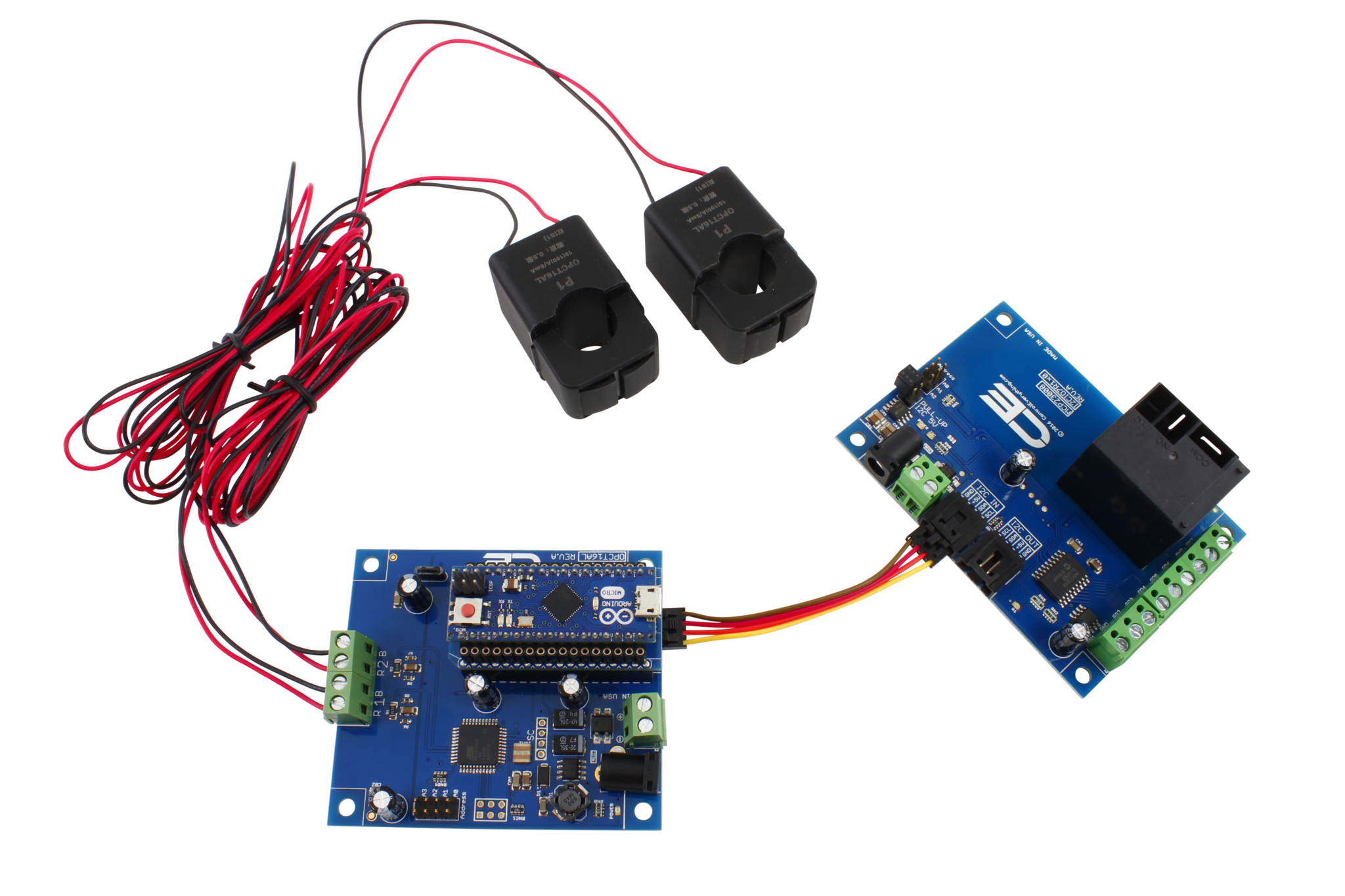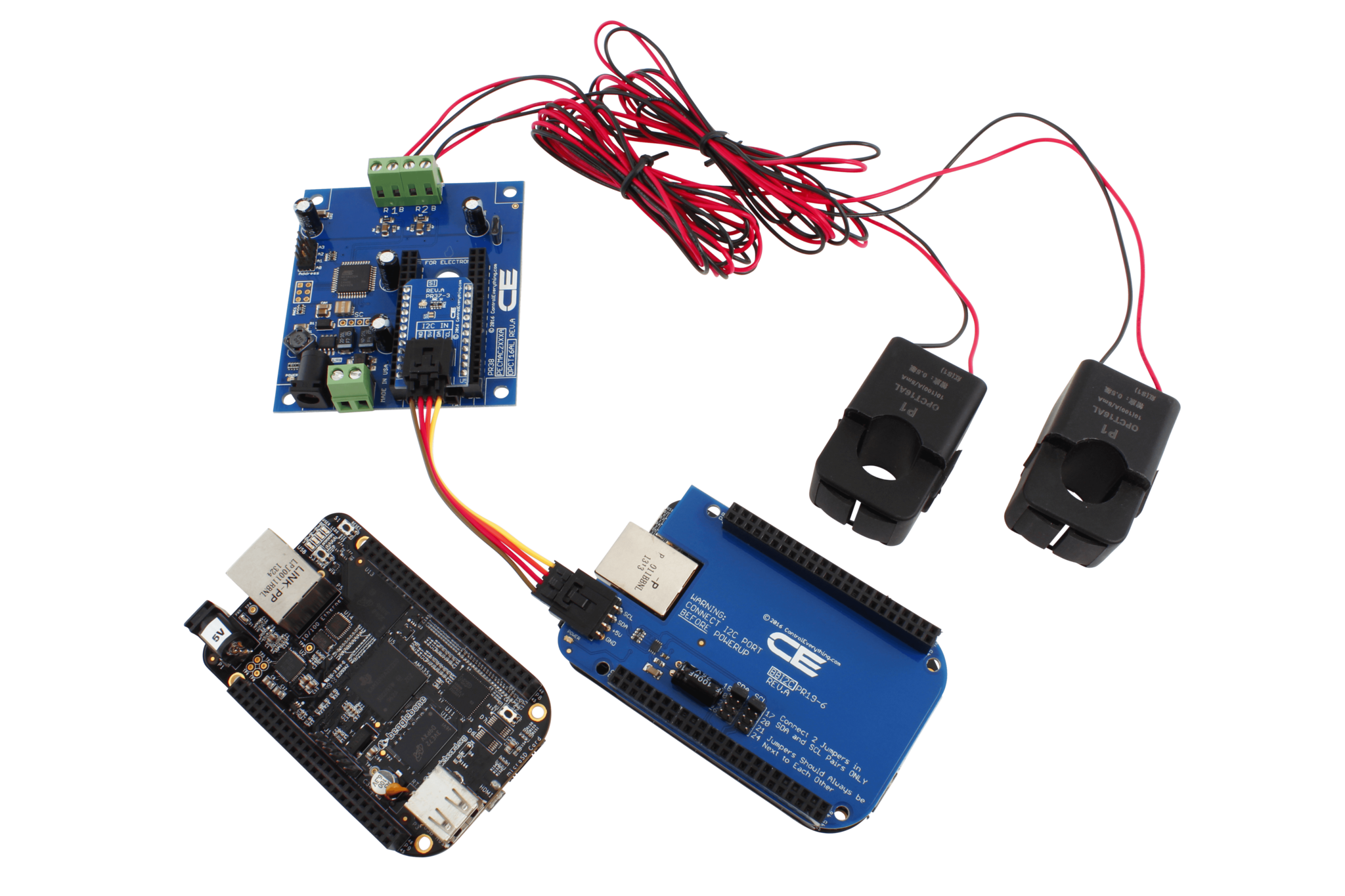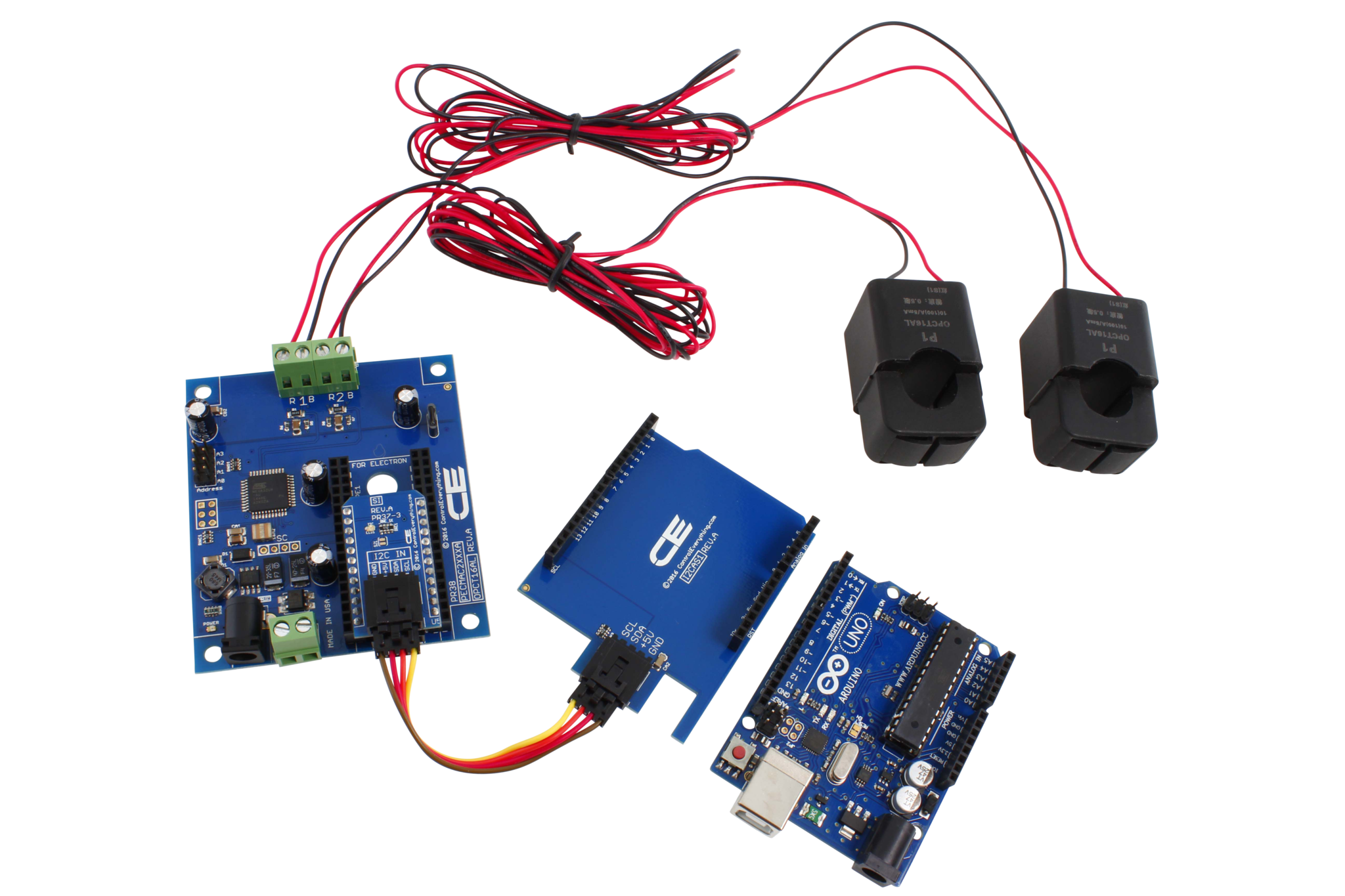2-Channel Off-Board 98% Accuracy AC Current Monitor with IoT Interface
Highlights
- 2-Channel 10 to 100-Amp Current Measurement for IoT Energy Monitoring
- Energy Monitoring for IoT Cloud Applications
- Use with Particle Electron for Cellular Communications
- Use with Particle Photon for WiFi Communications
- Use with Bluz Bluetooth Low Energy (BLE) Communications
- Adaptable to Raspberry Pi, Arduino, and Other Platforms
- On-Board Processor Manages all Measurement Conversions
- I2C Expansion Port Offers Extensive Expansion Options
This 2-Channel high-accuracy current monitoring controller makes it easy to get AC current measurements into your favorite IoT cloud platform. This current monitoring controller is available pre-tuned in your choice of 10, 20, 30, 50, 70, and 100-Amp ranges.
Using our IoT interface, plug-in your favorite IoT communication module and develop firmware to read energy anywhere in the world! The NCD IoT interface support Particle Electron for cellular current monitoring. Use the Particle Photon to monitor current over WiFi. The IoT interface also supports Bluz (Bluetooth BLE) or you can use one of our adapters to plug in Arduino Nano, Arduino Micro, USB, PyCom WyPy, directly on-board! Plug in the SI I2C adapter for interface to Raspberry Pi, BeagleBone, or Arduino Uno. The NCD IoT interface standard makes it easy to connect to just about any computer or microcontroller!
Based on our plug-and-play I2C interface standard, all NCD IoT devices support I2C communications using a I2C expansion port, making it easy to expand to a wide variety of sensors, relay controllers, PWM controllers, and much more!
This controller handles all of the current calculations for energy monitoring applications. Use our Particle library to communicate energy monitoring data to the Particle cloud or adapt our library for your specific application using the Arduino wire language.
This device provides an ideal energy monitoring solution for most industrial and commercial applications at a low cost with unmatched accuracy.
This controller includes 2 off-board current sensors and an I2C cable.
To use this device, simply run an AC power wire through the opening of the current sensor. This controller will read the magnetic field inducted onto the current sensor and provide you with a real-world current measurement value that is 98% accurate (prior to calibration).
This current monitoring controller includes our second generation firmware, which maintains best possible accuracy when measuring inductive loads, minimizing the need for calibration. This controller is pre-calibrated for resistive loads, but has demonstrated 98% accuracy when measuring most inductive load sources.
Sensors:
This controller includes split-core sensors with 1.5 Meter wires (around 5 feet). Split-core sensors can be opened and clamped around existing wire, greatly simplifying installation.
I2C Expansion:
This controller includes an I2C expansion port and I2C cable so you can easily expand into other current monitoring controllers, sensors of all types, relay controllers, FET drivers, and much more.
Notes:
For AC Current Measurement Only. This controller is tuned specifically for the included sensors, and may not be used with any other sensor. The sensor rating of this controller is 100 Amps; however, this controller is tuned to measure the amps chosen during the add to cart process. It is not possible to measure current outside the tuned range of this controller. Never exceed 110% of the rated current range of this controller (30 Amps) or permanent damage to the controller may result. To achieve highest possible accuracy, each channel may require calibration for the type of load under measurement. As with all current sensors of this type, loads below 1 Amp (1% of the sensor rating) are known for significantly decreased accuracy (around 90% or less). To increase accuracy of low-current loads, consider doubling the readings by looping your AC load wire through the sensor a second time. This will effectively double all readings and provide greater low-end accuracy.
Excessively noisy loads may greatly affect accuracy, but our testing has shown 98% or better accuracy with most loads tested. This controller dedicates 1.3 seconds for measurement of each channel and cycles through all available channels continuously. We recommend querying this controller every 10 seconds for best results.
What is the NCD IoT Interface?
The NCD IoT Interface provides users with a means of changing or upgrading the IoT communications technology as new technologies emerge. The NCD IoT Interface is directly compatible with Particle Photon for WiFi communications, Electron for Cellular Communications, Bluz for Bluetooth. Optionally, adapters may be installed to provide a direct interface to Arduino Nano, Micro, USB, PyCom WyPy, Onion Omega, Raspberry Pi, and much more. The NCD IoT interface allows you to re-use your hardware so it never becomes obsolete! Based on I2C communications, the NCD IoT Interface uses only 2 GPIO lines of your microcontroller, freeing the rest of your CPU for other tasks.
nodeLynk™ IoT Device Expansion
This is a IoT Device which accepts a common processor and provides on-board sensing or control capabilities. This IoT device may be expanded to include additional hardware functionality using nodeLynk Expansion Devices. The NCD IoT socket found on IoT devices is capable of directly handling NCD ESP8266 and ESP32 series processors as well as Particle Photon and Particle Electron. We also manufacture many adapters for the NCD IoT socket for Arduino Nano, Micro, and Feather microprocessor modules. Between the socket is a nodeLynk connector, which is used for I2C Expansion.


What is nodeLynk?
Chain expansion devices using nodeLynk. Connect a wide variety of accessories to expand the capabilities of a nodeLynk compatible controller. Use nodeLynk to add Relay Controllers, Sensors, PWM Drivers, Displays, and a wide variety of 4-20mA, 0-10V ADCs and DACs, as well as a wide array of TTL & Isolated GPIO devices. All nodeLynk devices use I2C communications to chain devices together. nodeLynk is an easy way to expand functionality without soldering. nodeLynk allows expansion in seconds so you can focus on your software and firmware development.

Unlimited I2C Expansion
Based on our plug-and-play nodeLynk I2C interface standard, all NCD IoT devices are equipped with a nodeLynk I2C expansion port, making it easy to expand to a wide variety of sensors, current monitors, relay controllers, PWM controllers, and much more! We are always designing new nodeLynk expansions for our plug-and-play nodeLynk I2C framework. We are dedicated to building a product line of interconnected devices to simplify all forms of automation. Re-use or upgrade your hardware in seconds by selecting the modules that best fit your needs, and chaining them together using the included nodeLynk I2C expansion cables!
Mechanical Drawing
Wiring Diagrams
Documentation
Datasheets
Community Repositories
IoT Interface Compatibility
NCD IoT Interface devices are designed to plug in to many popular IoT computing platforms. This allows the “brains” from other manufacturers to directly plug into our devices for easy plug-and-play operation. IoT interface devices use I²C as the underlying communications technology. The notes below will guide you into plugging 3rd party IoT technologies into our devices, we will highlight any adapters that may be required in this section. Please note that all IoT Interface Devices act as a I²C Master Device, and may be expanded by connecting to any of our Cross-Platform nodeLynk I²C Slave Devices using the nodeLynk I²C Output.
NCD IoT Interface Direct Connection
The following devices directly plug into NCD IoT Interface controllers without a adapter.
- Particle Electron
- Particle Photon (Particle.io)
- Bluz Module (Bluz.io)
- ESP8266 Module
If using a Particle Photon or Particle Electron communications module, the PKFR Key Fob Receiver overlay shield may be used to add long-range wireless Key Fob remote control to the communications module.
NCD IoT Interface Adapters
Use the following adapters will adapt the IoT Interface for I2C communications with other popular computing platforms:
- Arduino Nano using the Arduino Nano Adapter
- Arduino Micro using the Arduino Micro Adapter
- Onion Omega 1&2 using the OC Adapter
- Pycom WiPy using the WiPy Adapter
- Pycom WiPy2 & LoPy using LoPy Adapter
- Adafruit Huzzah ESP8266 using the Adafruit Huzzah Adapter
- Windows using USB Interface and the USB IoT Interface Adapter
Convert IoT to I2C Interface Devices
- This device may be converted to an I²C slave device using the I2C to IoT Interface Adapter, ideal for use with Raspberry Pi, Beaglebone, Arduino Uno, and BridgeX5.
Arduino Interface
- Use the I2C to IoT Interface Adapter and a Arduino Uno Interface Adapter
- Use the I2C to IoT Interface Adapter and a Arduino Nano I²C Shield
- Use the I2C to IoT Interface Adapter and plug into any Arduino Nano Master Device
- Use the I2C to IoT Interface Adapter and plug into any Arduino Micro Master Device
- Use the I2C to IoT Interface Adapter and plug into any Arduino Due Master Device
BeagleBone Interface
- Use the I2C to IoT Interface Adapter and a BeagleBone I²C Interface Adapter
Banana Pi Interface
- Use the I2C to IoT Interface Adapter and a Banana Pi I²C Interface Adapter
C.H.I.P. Interface
- Use the I2C to IoT Interface Adapter and a C.H.I.P. I²C Interface Adapter
Raspberry Pi Interface
- Use the I2C to IoT Interface Adapter and a Raspberry Pi I²C Interface Adapter
- Use the I2C to IoT Interface Adapter and a Raspberry Pi 2/3 I²C Interface Adapter
- Use the I2C to IoT Interface Adapter and a Raspberry Pi Zero I²C Interface Adapter
Windows 8/10 PC Interface
- Use the I2C to IoT Interface Adapter and a USB to I2C Converter
- Use the I2C to IoT Interface Adapter and a BridgeX5 Series Controller
Key Fob Compatibility
NCD IoT Interface devices are also compatible with a 418MHz Key Fob receiver (Part Number: PKFR), allowing your Particle Electron, Photon, or Bluz to receive and process remote Key Fob commands up to 750 feet away. Up to 40 remote controls may be associated to the PKFR. Program your IoT communications module to receive wireless remote control commands using a Key Fob. Compatible with 1, 2, 3, 4, 5, and 8-Button MS Series Key Fobs from Linx Technologies.
Out of stock




